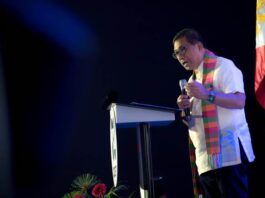“A dermatologist may not see this disease in his/her lifetime.” This is how Dr. Belen Dofitas, dermatologist of the University of the Philippines – Philippine General Hospital (UP-PGH), describes Tinea imbricata, a disease found infecting a tribe in Kiamba, Sarangani Province in Mindanao through the telemedicine project of the Philippine Council for Health Research and Development of the Department of Science and Technology (PCHRD-DOST) and the University of the Philippines National Telehealth Center (UP-NThC).
Tinea imbricata, also known as Tokelau ringworm, is an uncommon superficial fungal infection caused by Trichophyton concentricum. The disease is characterized by the formation of patches that are concentrically arranged, imbricated and known for its scaly rings and skin exfoliation.
“The disease is relatively rare. There are reports in scientific journals but only few around the world,” said Dr. Dofitas in an interview. In the history of dermatology in the Philippines, only three cases were reported – one in 1789 in Mindanao, another in 1962 in Mindoro and another in 1990, also in Mindanao. In all three cases, the disease occurred in ethnic and tribal groups.
“It was my first encounter with the disease and I have no idea about it,” said Dr. Lemuel Non, Municipal Health Officer and Doctor-to-the-Barrio (DTTB) of Kiamba, Sarangani Province, who found the disease on a walk-in patient in Kiamba Municipal Health Center. “What I did was, I photographed the infected part of the body of the patient, together with my initial assessment and forwarded it to the NThC via text messaging (SMS) and multimedia message (MMS) for evaluation and verification of the disease. It so happens that the municipality of Kiamba is one of the pilot sites of the UP-DOST telemedicine program.”
Telemedicine is an interactive audiovisual media that uses telecommunication and information technologies for the delivery of clinical care. It can be used for consultations, examinations and other remote medical procedures specifically designed to provide better health care services in the far-flung communities or the geographically isolated and disadvantaged areas (GIDA), where specialized medical experts are unavailable.
According to Mr. Sid Cardenas, technical staff from NThC, “when the assigned doctor does not know or is not sure what to do with the encountered disease/s in the field (particularly on specialist-specific diseases), this is where telemedicine helps.” The doctor forwards its initial assessment to the NThC servers through SMS, MMS or email. The report will be channeled to the telemedicine domain experts for diagnosis or management, and findings will be sent back to the doctor in remote site.
With the help of the UP-DOST telemedicine project, Dr. Non in Kiamba, Sarangani Province received relevant information from Dr. Dofitas in UP-PGH to properly handle the Tinea imbricata disease.
Beyond telemedicine
Since Tinea imbricata is a special case, the NThC technical staff together with the UP-PGH experts visited the municipality of Kiamba to conduct a follow-up health mission. “There may be other cases existing in the community. That is why we really need to go up there to find out the real situation of the tribe,” said Dr. Dofitas. “It is possible that some of their family members are also infected with the disease. Aside from that, we need to know how the community treats the disease and their perception about it.”
In cooperation with the local government of Kiamba, members of the tribe were invited for free medical consultations. “Because the tribe perceived that the disease is incurable, they were initially reluctant to be examined by the medical team. However, after learning that some of their members were successfully treated, the tribe was, eventually convinced,” said Dr. Dofitas. There were twenty eight individuals found infected with the rare disease.
“We also introduced “akapulko” for the treatment of the disease.” Akapulko is an indigenous herbal medicine abundant in the community that is found effective in curing skin diseases including Tinea imbricata.
Aside from medical consultations, the team also conducted information dissemination campaigns to increase the community’s awareness on the disease. “This is very important to change their mindset, to make them realize that the disease is curable,” said Dr. Dofitas.
Telemedicine project defies distance and lack of medical experts
According to the UP Manila – National Institutes of Health, 60 percent of Filipinos die without seeing a doctor. This may be due to the fact that being an archipelagic country, distribution of health care services could be a quite challenge.
“In an archipelagic country like the Philippines, telemedicine is an advantage to bring health care services in isolated and poor, underserved communities. It is a medical option that bridges “doctor-patient” geographical separation. Aside from that, it addresses the problem of lack of deployed experts in areas with high risks of diseases like Sarangani Province. That is why telemedicine is very important and should be incorporated in our health system,” said Dr. Dofitas.
She also emphasized that telemedicine has an important role in the continuing education of doctors, caregivers, and patients, and cuts the often high cost of travel and stay in nursing homes or hospitals through the efficient referral system among hospital experts anywhere in the country. Edmon B. Agron, PCHRD





This surely makes great sense
Reblogged this on TUKLASIN NATIN.